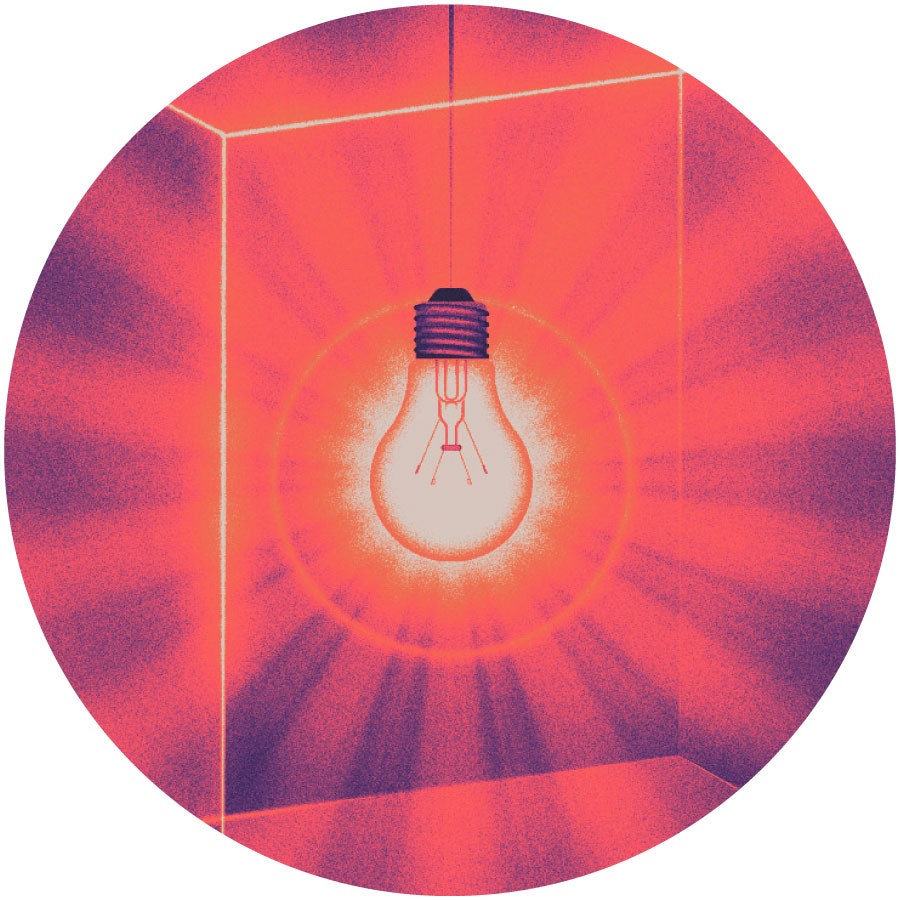Remember we’re dealing with the photon’s wave function here. Since the bounce doesn’t constitute a measurement, the wave function doesn’t collapse. Instead, it splits in two: Most of the wave function remains in the box, but the small, rapidly oscillating piece near where the mirror was inserted leaves the box and heads toward the detector.
Because this superoscillatory piece has been plucked from the rest of the wave function, it is now identical to a photon of much higher energy. When this piece hits the detector, the entire wave function collapses. When it does, there’s a small but real chance that the detector will register a high-energy photon. It’s like the gamma ray emerging from a box of red light. “This is shocking,” said Popescu.
The clever measurement scheme somehow imparts more energy to the photon than any of its wave function’s components would have allowed. Where did the energy come from?
Legal Ambiguities
The mathematician Emmy Noether proved in 1915 that conserved quantities like energy and momentum spring from symmetries of nature. Energy is conserved because of “time-translation symmetry”: the rule that the equations governing particles stay the same from moment to moment. (Energy is the stable quantity that represents this sameness.) Notably, energy isn’t conserved in situations where gravity warps the fabric of space-time, since this warping changes the physics in different places and times, nor is it conserved on cosmological scales, where the expansion of space introduces time-dependence. But for something like light in a box, physicists agree: Time-translation symmetry (and thus energy conservation) should hold.
Applying Noether’s theorem to the equations of quantum mechanics gets complicated, though.
In classical mechanics, you can always check the initial energy of a system, let it evolve, then check the final energy, and you’ll find that the energy stays constant. But measuring the energy of a quantum system necessarily disturbs it by collapsing its wave function, preventing it from evolving as it otherwise would have. So the only way to check that energy is conserved as a quantum system evolves is to do so statistically: Run an experiment many times, checking the initial energy half the time and the final energy the other half. The statistical distribution of energies before and after the system’s evolution should match.
Popescu says the thought experiment, while perplexing, is compatible with this version of conservation of energy. Because the superoscillatory region is such a small part of the photon’s wave function, the photon has a very low probability of being found there—only on rare occasions will the “shocking” photon emerge from the box. Over the course of many runs, the energy budget will stay balanced. “We do not claim that energy conservation in the … statistical version is incorrect,” he said. “But all we claim is that that is not the end of the story.”
The problem is, the thought experiment suggests that energy conservation can be violated in individual instances—something many physicists object to. David Griffiths, a professor emeritus at Reed College in Oregon and author of standard textbooks on quantum mechanics, maintains that energy must be conserved in each individual experimental run (even if this is normally hard to check).
Marletto agrees. In her opinion, if it looks as if your experiment is violating this conservation law, you’re not looking hard enough. The excess energy must come from somewhere. “There are a number of ways in which this alleged violation of the energy conservation could come about,” she said, “one of which is not fully taking into account the environment.”
Popescu and his colleagues think they have accounted for the environment; they suspected that the photon gains its extra energy from the mirror, but they calculated that the mirror’s energy does not change.
The search continues for a resolution to the apparent paradox, and with it, a better understanding of quantum theory. Such puzzles have been fruitful for physicists in the past. As John Wheeler once said, “No progress without a paradox!”
“If you ignore such questions,” Popescu said, “you’re never really going to … understand what quantum mechanics is.”
Original story reprinted with permission from Quanta Magazine, an editorially independent publication of the Simons Foundation whose mission is to enhance public understanding of science by covering research developments and trends in mathematics and the physical and life sciences.



